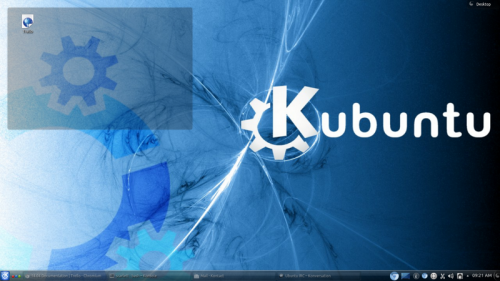Kubuntu/Podstawy
Ta część Dokumentacji obejmuje komponenty w ramach Kubuntu, które spełnią twoją pożądaną funkcjonalność i dostosują Kubuntu do twoich potrzeb.
Sieci
Ten dział pomoże ci w uzyskaniu połączenia z internetem.
Sieci Przewodowe
W większości przypadków połączenia przewodowe będą po prostu działać bez żadnych zmian w domyślnej konfiguracji Kubuntu. Połączenia przewodowe są wybierane jako domyślne, gdy są dostępne.
Sieci Bezprzewodowe
Większość kart bezprzewodowych jest wspierana domyślnie w Kubuntu. Jednakże, w niektórych przypadkach, urządzenia sieci bezprzewodowej potrzebują własnościowych sterowników do działania. Najlepszym sposobem, aby to sprawdzić jest otwarcie programu jockey-kde (zwanego też 'Additional Drivers'). Aby otworzyć ten program kliknij aktywator Kickoff i wyszukaj Additional Drivers. Jeśli urządzenie potrzebuje własnościowych sterowników, wtedy jockey-kde pomoże w wyborze, instalacji i uruchomieniu właściwych sterowników. Gdy już to wszystko zrobimy, system będzie musiał być ponownie uruchomiony. Aby uzyskać więcej informacji na temat rozwiązywania problemów z bezprzewodowym dostępem do Internetu w systemie, sprawdź stronę Wireless Troubleshooting.
Launchers
Kickoff
As a KDE distribution, Kubuntu uses the Application Launcher by default. The Launcher can be compared with the 'Start Menu' in Windows (pre Windows 8). The icon to launch is on the bottom left very much like Windows XP or 7. For more information on how to use and customize it, see Plasma Kickoff.
KRunner
Podobnie jak jest aktywatorem, ale potrafi on o wiele więcej niż uruchamianie aplikacji. Zazwyczaj jest dostępny po naciśnięciu Alt + F2. Aby uzyskać więcej informacji o tym co on potrafi, zajrzyj na stronę Plasma Krunner.
Desktop Customization

ThemesKubuntu allows themes to be changed easily. Open and choose in the section, then choose from the list of installed themes. You can change the theme of the Window Decoration, Cursor Theme, Desktop Theme, and the Splash Screen. Pick from the default choices that are installed, or left-click the 'Get New...' button in each section for more choices. PlasmoidsPlasmoids (also called Widgets) can be added by right-clicking the desktop and selecting , which will bring up a list of Widgets. For more information, see Plasma Widgets.
PanelBy right-clicking on the desktop once again, you can select to get more panels. You can left-click the button on the far right side of the panel to alter the properties of the panel, like changing its height or width or adding Widgets, for example. For more information, see Plasma Panels. DolphinDolphin is the default file manager in Kubuntu and can be compared with Windows Explorer. Dolphin looks simple because of great design, while having many powerful features. For more information, see Dolphin. UpdatingKubuntu developers release feature and security updates for applications and packages within the Kubuntu system. When updates become available, Kubuntu will display a message in the System Tray. To update the system, open and click the button. After installing some updates, it may be necessary to restart the computer. If so, Kubuntu will display a pop-up and an icon in the System Tray. |
